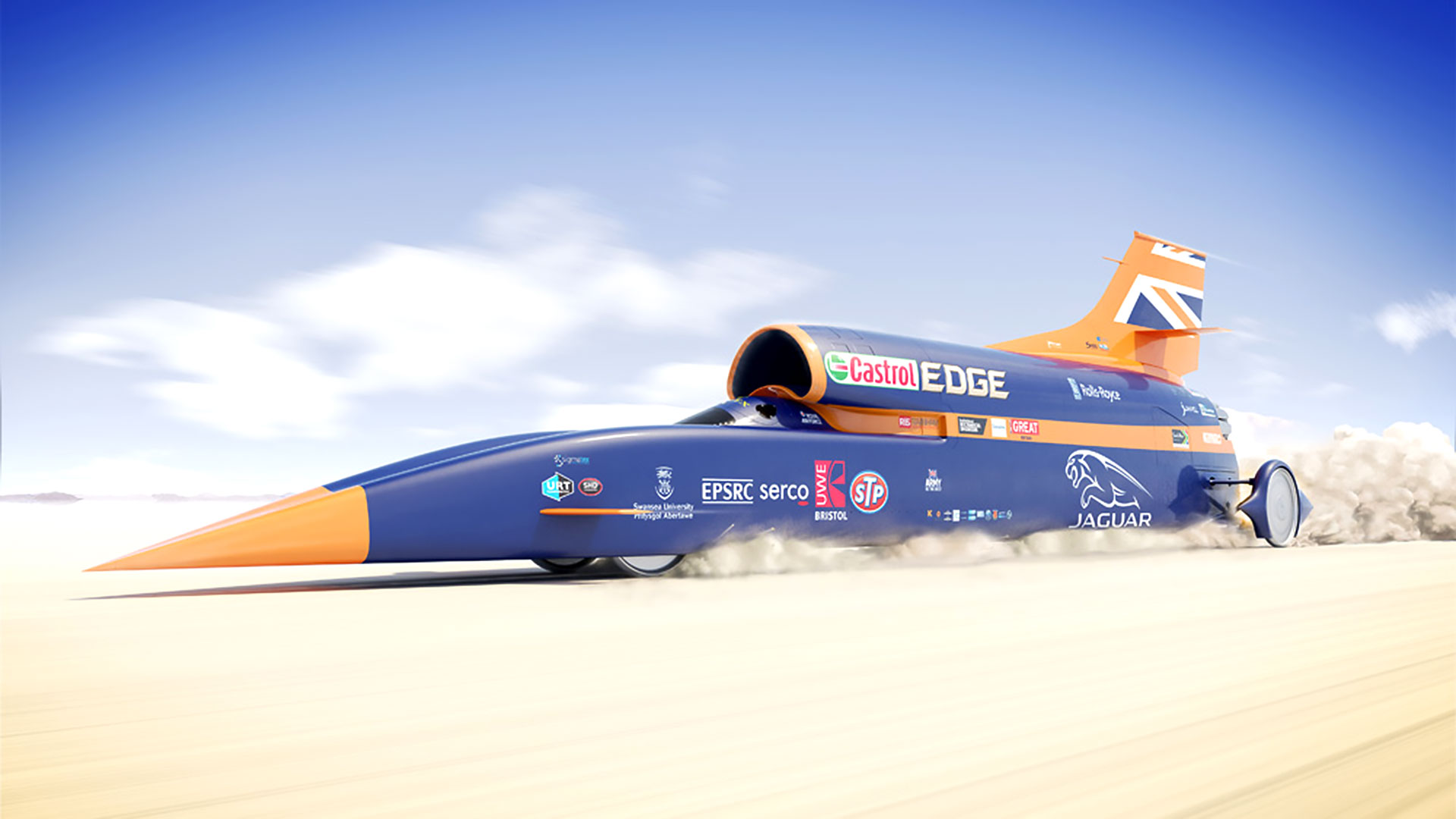

British pilot Andy Green routinely cracks supersonic speeds in his day job with the Royal Air Force. That’s not half as interesting as what he does for fun. Green is the only man alive to crack the speed of sound in a wheeled vehicle. He set the current land speed record of 763 mph in a jet-powered car called Thrust SSC, in the Black Rock Desert of Nevada in 1997. That’s quick enough to cross 3.7 football fields in a single second. Or, roughly 200 mph faster than the top speed of a 747.
Green’s latest goal: to drive 1,000 mph in a new jet-powered car called Bloodhound SSC, which he will be testing this year. We caught up to Green, who explained this all in remarkably poetic terms. Turns out, there is more to this experiment than a blindingly fast jet car and a man with the balls to drive it.
On building Bloodhound (ie, the build of the world’s fastest car):
“We have got the great majority of the first iteration of the car built—90%-plus of the bits to start runway testing. It’s the first dry build. Not with the final seals and the oils and everything else needed for the full shake down. But the first dry build to make sure everything fits together. We launched this at the end of last year and there was a phenomenal response. For the rest of this year we will finish putting the car together and getting it ready to start testing at the end of 2016. Full complete testing—if I had to guess—will be around the middle of 2017 in South Africa, so we can start attacking the current record and developing the car for 1,000 mph.”

The Bloodhound SSC is about 13.4 meters long, and will weigh about 7.5 tons when complete. It has a jet engine and a rocket, which together will produce 135,000 horsepower, according to the team. But that’s not all…
“We’ve got a Jaguar 5-liter 550-horsepower supercharged V8 just to drive the pump motor for the rocket system in the car. That should give you an idea of how powerful the rocket system is. But we’re not just building the world’s fastest car. It’s also going to be the world’s fastest outside broadcast platform. We’re fitting it with video cameras and a data system. When we run the car, we’re going to run live video and live data to the internet. Wherever you are in the world, you can watch the car run as we do it, and analyze data before our engineers even get the chance to look at it. NASA has never done that. Formula 1 has never done that. The military certainly doesn’t do that. Land speed record racing is the only field of competition where you develop very advanced technology and then give it all away. You’re building something no one else is going to make, so all our secrets are public. You can have them.

On the point of this whole thing:
“What we’re trying to achieve is not just another land speed record. Let’s face it: We already hold it. We saw an opportunity to face a wider problem, which was to create an engineering adventure which would engage and inspire a generation. Particularly the generation in school, who will be building and living in the high-technology, low-carbon, energy-efficient world of the future. We want to design something so remarkable that it can deliver that Apollo-moment for the 21st century. To do that, we want to ask: What is the limit of modern technology? How fast is it possible for a land vehicle to go? In the end, it doesn’t matter if we get to 1,000 mph. We may only get to 950 mph. Or, we might get to 1,050 mph and find we have loads of power left (but I don’t believe that, because none of these cars ever have as much performance as you expect). What matters is that 20 million kids are engaged in the science, watching it live. It matters that 10-year old girls are postulating whether it is the lack of aerodynamics or the rolling resistance of the wheels that is stopping us from going faster.”

On what’s it’s like to drive 763 mph:
“I’ve done high-speed track driving and I’ve got a career flying jet fighters. [Driving 763 mph is] like driving a track car at jet fighter speeds, in some respects. And yet, maybe it’s more simple because you don’t have to worry about racing in the rain, traffic, bends, and you’re not getting airborne. But all that doesn’t really help explain it unless you’re a high speed track driver and a supersonic jet pilot. So let me default to this explanation. Somebody once asked Art Arfons [who set land speed records in the 1960s] [link https://www.youtube.com/watch?v=4JU0dCCqzU8] that question and he said, ‘It’s a bit like the taste of chocolate. If you’ve never had a bar of chocolate, I’m really going to struggle to explain this experience to you.’”

On the beautiful round number of 1,000 mph:
Richard Noble [a partner in Bloodhound SSC and a former land speed record holder] set the design team at 50% faster than our previous car. That’s Mach 1.5, or 50% faster than the speed of sound. He said, Is that achievable? I came back and said no. However, I thought we could get close to Mach 1.4. That’s about 1,060 mph. After more study, a more sensible maximum speed seemed about Mach 1.35 or 1.36. Which happens to be about 1,000 mph. This puts us under a huge amount of pressure, because it’s the world’s first four-figure target speed. It all works backward from a simple question: What will the technology permit?